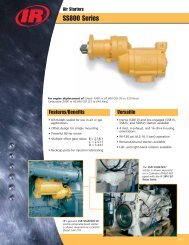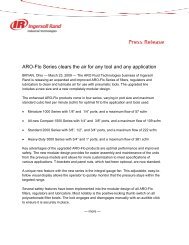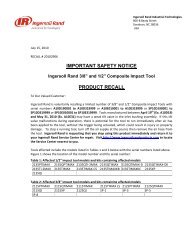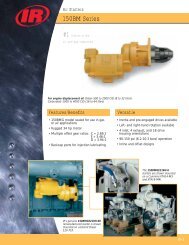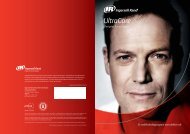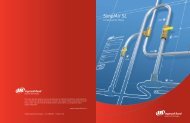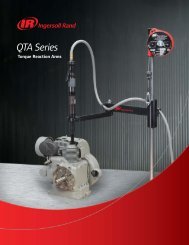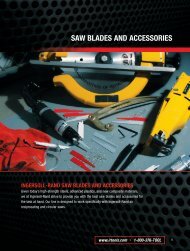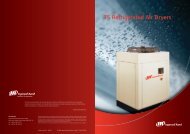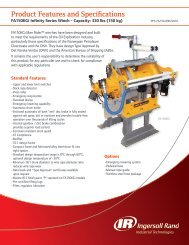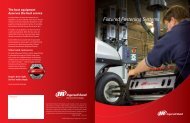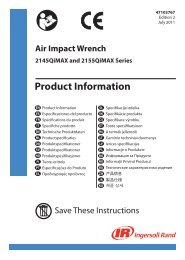1504 Wetsol - Ingersoll Rand
1504 Wetsol - Ingersoll Rand
1504 Wetsol - Ingersoll Rand
You also want an ePaper? Increase the reach of your titles
YUMPU automatically turns print PDFs into web optimized ePapers that Google loves.
Section 1. Product and Company IdentificationMaterial Safety Data Sheet Number: <strong>1504</strong>Product Name: WET-SOL “PLUS” UPPER PACKING LUBRICANTValidation Date : 05/12/2011Emergency Telephone Number : 1-800-535-5053Information Telephone Number (616) 672-7503Fax : (616) 685-0773Chemtrec Phone : 1-800-424-9300; Internationally call 703-527-3887MSDS authored by:: INGERSOLL-RAND PLC800 Beaty Street, Davidson, NC 28036Additional InformationManufacturerGLCC Product NameSynonymsGLCC MSDS Number : 00668Telephone Number : 1-800-949-5167Product Use: Great Lakes Chemical Corporation, A Chemtura CompanyP.O. Box 2200West Lafayette, Indiana 47996-2200: Kronitex TCP: Tricresyl phosphate; Tritolyl phosphateSection 2. Composition, Information on IngredientsWET-SOL “PLUS”Part Number: 66334-B: General purpose flame retardant plasticizer for vinyl; processing aid and plasticizerfor NBR and SBR synthetic and natural rubbers.Ingredient Name CAS Number Percentage Exposure LimitsTricresyl Phosphate 1330785 100% Y (Hazardous)Not established (OSHA PEL TWA)Not established (OSHA PEL STEL)Not established (OSHA PEL CEIL)Not established (ACGIH TLV TWA)Not established (ACGIH TLV STEL)Not established (ACGIH TLV CEIL)* Indented chemicals are components of previous ingredient.Section 3. Hazards IdentificationEmergency OverviewRelevant Routes of ExposureSigns and Symptoms ofOverexposureMedical Conditions GenerallyAggravated By ExposurePotential Health EffectsEye ExposureSkin ExposureIngestionInhalationChronic Health Effects: Colorless liquid.No Odor.May cause mucous membrane and upper respiratory tract irritation.Mist generated by heat, violent agitation or spraying will irritate skin, eyes, nose,throat and respiratory system.: Ingestion, inhalation and skin absorption: General reddening and irritation to the skin and eyes, mucous membraneirritation, upper respiratory tract irritation.: None reported: See Section 6 for additional information.: May cause mild eye irritation.: Not expected to be a hazard in normal industrial use.: Not expected to be a hazard in normal industrial use.: May cause mucous membrane and upper respiratory tract irritation.: May cause adrenal, reproductive and developmental effects based on animal data.Page 1 of 6 Material Safety Data Sheet Number <strong>1504</strong> WET-SOL “PLUS” / Part Number 66334-B
CarcinogenicityNTPIARCOSHAACGIHOTHER: No: No: No: No: NoSection 4. First Aid MeasuresEye contactSkin contactIngestionInhalationAntidotesNotes to Physicians and/orProtection for First-Aiders: Flush with large volumes of water for at least 15 minutes. Get medical attention.: While removing clothing, wash with large volumes of soap and water for at least15 minutes. If irritation develops, get medical attention.: If conscious, give person 1 to 2 glasses of water. Get medical attention immediately.: Remove person to fresh air. Get medical attention.: No information available.: May be irritating to skin, mucous membranes and eyes. Though anorganophosphate, it has only extremely weak anticholinesterase activity whichshould not require specific treatment (e.g. atropine and cholinesteraseregenerators). Treatment is supportive and symptomatic after terminatingexposure through washing, emesis or lavage. If inhalation exposure is severe,observation for up to 72 hours for delayed onset of severe pulmonary edemashould be considered.Section 5. Fire-fighting MeasuresFire and Explosive Properties in Air(% by Volume) : Not available.Flashpoint: 225° C (437° F) (PMCC)Autoignition Temperature : 607° C (1125° F)Extinguishing Media: All conventional media are suitable.Fire Fighting Instructions: Wear a self-contained breathing apparatus and protective clothing to prevent skinand eye contact in fire situations.Unusual Fire and Explosion Hazards : Not flammable but combustible if exposed to external flame. No explosion hazard.Flammability Classification: Non-flammable liquid.Known or Anticipated HazardousProducts of Combustion: Oxides of phosphorus, Carbon monoxide and carbon dioxide.Section 6. Accidental Release MeasuresAccidental Release Measures : Wearing appropriate personal protective equipment, collect spill with the aid ofan inert absorbent and place in suitable labeled containers for disposal.Personal Precautions : See Section 8.Environmental Precautions : No information available.Section 7. Handling and StorageHandlingStorageOther Precautions: Use appropriate personal protection equipment.Avoid eye, skin and clothing contact.Do not breathe mist or vapor.Avoid repeated and prolonged contact.Avoid the generation of aerosols from spraying, pouring or vigorous agitation wheneverpossible, particularly if product is heated. If the generation of airborne materials cannot beavoided, exhaust ventilation and/or personal protective equipment as described in Section 8should be used.: Store in a cool, dry, well-ventilated area away from incompatible materials.Keep container tightly closed. Protect containers against damage.: Avoid contact of material with heat and open flame.Page 2 of 6 Material Safety Data Sheet Number <strong>1504</strong> WET-SOL “PLUS” / Part Number 66334-B
Section 8. Exposure Controls / Personal ProtectionEngineering ControlsVentilation RequirementsPersonal Protective EquipmentEye/Face ProtectionSkin ProtectionRespiratory Protection: Avoid the generation of airborne mist where possible. When processing at hightemperatures, local exhaust ventilation or personal protective equipment asindicated below may be necessary to control exposure to a slightly irritating byproduct.: Use local ventilation to keep levels below established threshold values.Use mechanical ventilation for general area control.: Chemical safety goggles.: Gloves - butyl or nitrile rubber.Clothing designed to minimize skin contact.Wear an apron or impervious clothing and rubber boots if splashing is expected.: Wear a NIOSH/MSHA approved organic cartridge respirator if misting or vaporoccurs, or there is potential for airborne exposures to exceed establishedthreshold values.Consult the OSHA respiratory protection information located at 29CFR 1910.134and the American National Standard Institute’s Practices of RespiratoryProtection Z88.2.Wear a NIOSH/MSHA approved self-contained breathing apparatus inemergency situations.Other Protective Clothing orEquipment:: No information available.Exposure Guidelines : See Section 2.Work Hygienic Practices: Wash thoroughly after handling.Wash contaminated clothing before reuse.Section 9. Physical and Chemical PropertiesPhysical Appearance : Colorless liquid Percent Volatile : 0Boiling Point : 241 -255° C at 4 mm Hg pH Value: : Not availableBulk Density : Not available pH Concentration : Not availableColor : Colorless Physical State : LiquidDecomposition Temperature : >300° C Reactivity in Water : Not water reactiveEvaporation Rate : Not available Saturated Vapor Concentration : Not availableFreezing Point :
Section 11. Toxicological InformationValue (LD5O OR LC5O) Animal Routes Components11.1 mg/L Rat Acute Inhalation Tricresyl phosphate>10,000 mg/kg Rabbit Acute Dermal Tricresyl phosphate>5,000 mg/kg Rat Acute Oral Tricresyl phosphateToxicological Information:This product has low acute oral and dermal toxicity and is minimally irritating to the eyes and non-irritating to the skin.Product may be irritating to the respiratory system and mucous membranes.Historical data on tricresyl phosphate have shown neurological effects, widely viewed by experts as resulting from varyinglevels of ortho-cresyl phosphates, known neurotoxins. However, recent data on tricresyl phosphate, low in ortho-cresylphosphates, have not shown neurotoxic effects. Current Great Lakes Chemical Corporation branded products of tricresylphosphate were evaluated for acute delayed neurotoxicity in hens orally administered a single dose of 2000 mg/kg of bodyweight. Brain NTE activity was minimally reduced in all samples tested, with NTE inhibition levels being
Section 14. Transport InformationU.S. DOTProper Shipping Name : Environmentally hazardous substances, liquid, n.o.s. (Tricresyl Phosphate less than1% Ortho-Isomer)Hazard Class : 9 ID Number : UN3082Packing Group: : Ill Labels : 9, Marine PollutantSpecial Provisions : 8,IB3,T4,TP1,TP29, 146 Packaging Exceptions : 155Non-Bulk Packaging : 203 Bulk Packaging : 241Passenger Air/Rail : No Limit Air Cargo Limit : No LimitLimitVessel Stowage : A Other Stowage : N/AReportable Quantity : N/AAIR - ICAO OR IATAProper Shipping Name : Environmentally hazardous substances, liquid, n.o.s. (Tricresyl Phosphate less than1% Ortho-Isomer)Hazard Class : 9 ID Number : UN3082Subsidiary Risk : N/A Packing Group : IDHazard Labels : Micellaneous, Marine Pollutant Packaging Exceptions : 914;LQ Y9l4Air Passenger LimitPer Package : See BelowAir Cargo Limit PerPackage : No LimitPacking Instruction -Cargo : 914Special ProvisionsCode: A97WATER - IMDGProper Shipping Name : Environmentally hazardous substances, liquid, n.o.s. (Tricresyl Phosphate less than1% Ortho-Isomer)Hazard Class : 9 ID Number : UN3082Packing Group : III Subsidiary Risk : N/AMedical First AidGuide Code : NAAdditional InformationAir Maximum Net Quantity: No Limit; LQ 30kg GEmergency Procedures Code: F-A, S-FMarine PollutantSection 15. Regulatory informationU.S FederalRegulations: The components of this product are either on the TSCA Inventory or exempt (i.e. impurities, apolymer complying with the exemption rule at 40 CFR 723.250) from the Inventory.State Regulations : New Jersey Right To Know Hazardous Substance List. (1% reporting limit)InternationalRegulations:: This material (or each component) is listed on the following inventories:Canada - DSLElJ-EINECSAustralia - AICSJapan - ENCSKorea - ECLPhilippines - PICCSChina-List ICanadian Disclosure List (1%) - Tricresyl phosphateCanadian WHMIS Hazard Class and Division D.2.a, D.2.b.SARA HazardsAcute : Yes Chronic : YesReactive : No Fire : NoPressure : NoMaterial Safety Data Sheet Number <strong>1504</strong> WET-SOL “PLUS” / Part Number 66334-B Page 5 of 6
Additional InformationNote: The above regulatory information represents only selected regulations and is not meant to be a complete list.Section 16. Other informationNFPA Codes :Health : 1 Flammability : 1Reactivity : 0 Other : 0HMIS Codes : * indicates chronic health hazard.Health : 1* Flammability : 1Reactivity : 0 Protection : XLabel Statements : Not availableOther Information : Abbreviations:(L) = Loose bulk density in g/mlLOEC = Lowest observed effect concentrationMATC = Maximum acceptable toxicant concentrationNA = Not availableN/A = Not applicableNL = Not limitedNOAEL = No observable adverse effect levelNOEC = No observed effect concentrationNOEL = No observable effect levelNR = Not rated(P) = Packed bulk density in g/mlPNOR = Particulates Not Otherwise RegulatedPNOS = Particulates Not Otherwise SpecifiedREL = Recommended exposure limitTS = Trade secretAdditional Information:Information on this form is furnished solely for the purpose of compliance with OSHA’s HazardCommunication Standard, 29CFR 1910.1200 and the Canadian Hazardous Products Act and associatedControlled Products Regulations and shall not be used for any other purpose.Material Safety Data Sheet Number <strong>1504</strong> WET-SOL “PLUS” / Part Number 66334-B Page 6 of 6



